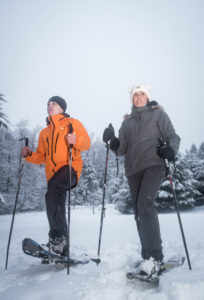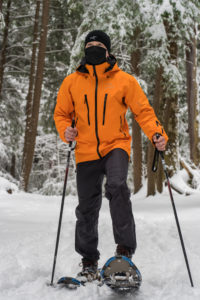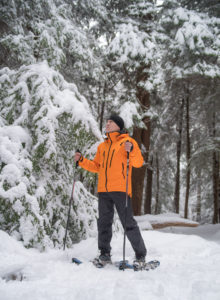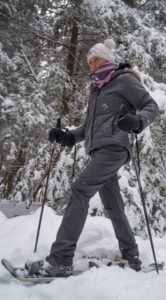Enjoy Winter's Splendor & Try Snowshoeing
You may not be able to walk on sunshine or walk on water. But you can walk on snow. The sport, or activity, of snowshoeing has been around for centuries and is done all over the world. Of course, the only ingredient you really need is — you guessed it — snow. “It is fundamentally one of the easiest sports,” said Russ Myer, Executive Director of the Capital Region Nordic Alliance (CRNA), a Move United member organization based in Albany, New York. “You can literally do it anywhere in the winter.”

There are lots of reasons to participate in snowshoeing. One of them, of course, is the health benefits it provides. “It is a great aerobic workout,” Myer said. “It works out the heart, the body, and the mind.” Myer suggests that snowshoeing can provide you with a different perspective of winter. “For some, winter is cold, it is slippery outside, and it gets dark early. This allows you to experience the season in a different way.”
The opportunity to be outside and enjoy the splendor of nature is definitely another benefit. “Snowshoeing is very calming and relaxing,” said Dana Dodge, Operations Manager at New England Disabled Sports (NEDS), a Move United member organization based in Lincoln, New Hampshire. “You don’t run into a lot of people.” During a time when the country is still in the midst of a pandemic, this activity provides the opportunity to be outside, enjoy nature, get exercise, and still adhere to physical distancing guidelines and recommendations.
Dodge also believes snowshoeing provides an alternative to traditional downhill, or alpine, skiing. “If you are hesitant to go skiing or you’ve tried that sport and it isn’t for you, snowshoeing allows you to enjoy all the outdoors has to offer.”
EQUIPMENT
Snowshoeing is a relatively inexpensive sport, particularly in comparison to other winter adaptive sports. “Compared to renting or buying skis, bindings, and poles, the price is much better,” said Jeff Inouye, Ski Programs Director at Breckenridge Outdoor Education Center (BOEC), a Move United member located in Breckenridge, Colorado.

The primary piece of equipment is, of course, the snowshoes. To give you a simple visualization, Inouye suggests envisioning putting a tennis racket on your feet. It has an outer frame, which can be made from a variety of materials including wood, vinyl, or aluminum, along with decking and a support system. “The shoe provides an enhanced surface area that allows you to walk in deeper snow versus sinking,” Myer said. “This process is called floatation and the decking gives you the floatation.” There are different sizes and lengths and selecting the one that best works for you is often based on weight. The more you weigh, the longer and wider typically.
If you come out to an adaptive sports program in the Move United network, all you normally have to do is bring yourself, as the equipment is provided. Of course, dress accordingly. “We recommend bringing two pair of sneakers and two pair of wool socks,” Myer said. “Wool is a natural fiber that is very insulated. Dress in layers with the base layer that wicks moisture away, but you don’t need all the apparel needed for alpine skiing, for example.”
You also need to bring fluids with you so you can keep well hydrated. “We sometimes forget about hydration during winter,” Dodge said. “Just because you are not hot, you are still doing physical activity.” She recommends bringing a backpack or hydration pack with you on the experience. You can also bring other core essentials you need or items you may want in case of an emergency.
There are various tools and means that can assist you, depending on your disability. Nordic or ski poles can provide additional support and balance. Outriggers can do the same and help with coordination. Applying the same technique as alpine skiing, snow sliders can also be utilized. And finally, some shoes have claws on the bottom to help with traction.
KNOW BEFORE YOU GO
To Inouye, snowshoeing is simply winter hiking. “If you can’t get out and do your traditional hiking (due to inclement weather or the elements), this is a great option. “There is not a lot of technique required and you can go at your own pace.”
He also suggests you don’t need to have an adaptive organization near you to partake in the activity. Myer agrees. “You can snowshoe at a local park, a golf course, nearby trails, or a wildlife preserve. You can do so in any depth of snow.”
I f you are ambulatory, it is a pretty easy transition from what you are already accustomed to do to get around. Myer states to become an intermediate snowshoer, all you have to do is don your snowshoes and take your first step. “To become an advanced snowshoer, take your second step,” he stated.
f you are ambulatory, it is a pretty easy transition from what you are already accustomed to do to get around. Myer states to become an intermediate snowshoer, all you have to do is don your snowshoes and take your first step. “To become an advanced snowshoer, take your second step,” he stated.
Putting on snowshoes is easy. The footwear you wear or bring with you should be waterproof, so it can keep you dry and warm because sometimes your feet can still get wet. You slide the front end of your shoe under a strap and tighten or adjust the straps accordingly.
A couple things to keep in mind once you are ready to go. First, you will want to widen your walking stance because you have something bigger than a normal shoe. You will also want to make sure the snowshoes stay level. “You don’t want the front end to dig into the snow or it could lead to losing your balance and falling,” Inouye said.
OTHER CONSIDERATIONS
When you are just getting into the sport, Dodge recommends starting with groomed trails or walking paths until you get the hang of it. “Then you can venture out on an unbroken trail. They were originally designed to go off trail.”
For individuals who aren’t ambulatory, Nordic skiing is the closest equivalent option. Many Nordic centers offer opportunities to engage in both activities in the same location. The biggest difference is that Nordic skiing relies on terrain that has been groomed or has existing tracks already laid down.

Myer also recommends that individuals with a leg amputation need to monitor their energy utilization as well as the impact on their residual limb and skin. “Shorter distances are good so you can check to make sure everything is okay.”
Once you have snowshoeing down pat, there are other things you can do. Myer often incorporates games such as football or soccer into their program’s activities.
In addition, there are ways you can take your love of the sport to the next level. For example, there are racing series and racing events, including 10K, 50K, and other distance races. Along those lines, snowshoeing provides a great cross-training opportunity during the winter for marathon and long-distance runners.
FIND A PROGRAM
Over 30 Move United member organizations across the country offer snowshoeing as one of their adaptive sports. To learn more, visit moveunitedsport.org/chapters/ location-map/.
Some locations offer regular weekly programs throughout the winter season while others are able to offer it seven days a week. In most cases, reservations are required or at least highly recommended.
Since snowshoeing is a low-impact activity, for many it can become a lifelong sport. “There is much less wear and tear on the body,” Dodge said. “You can also buy one pair of snowshoes and they can last a long time.”


